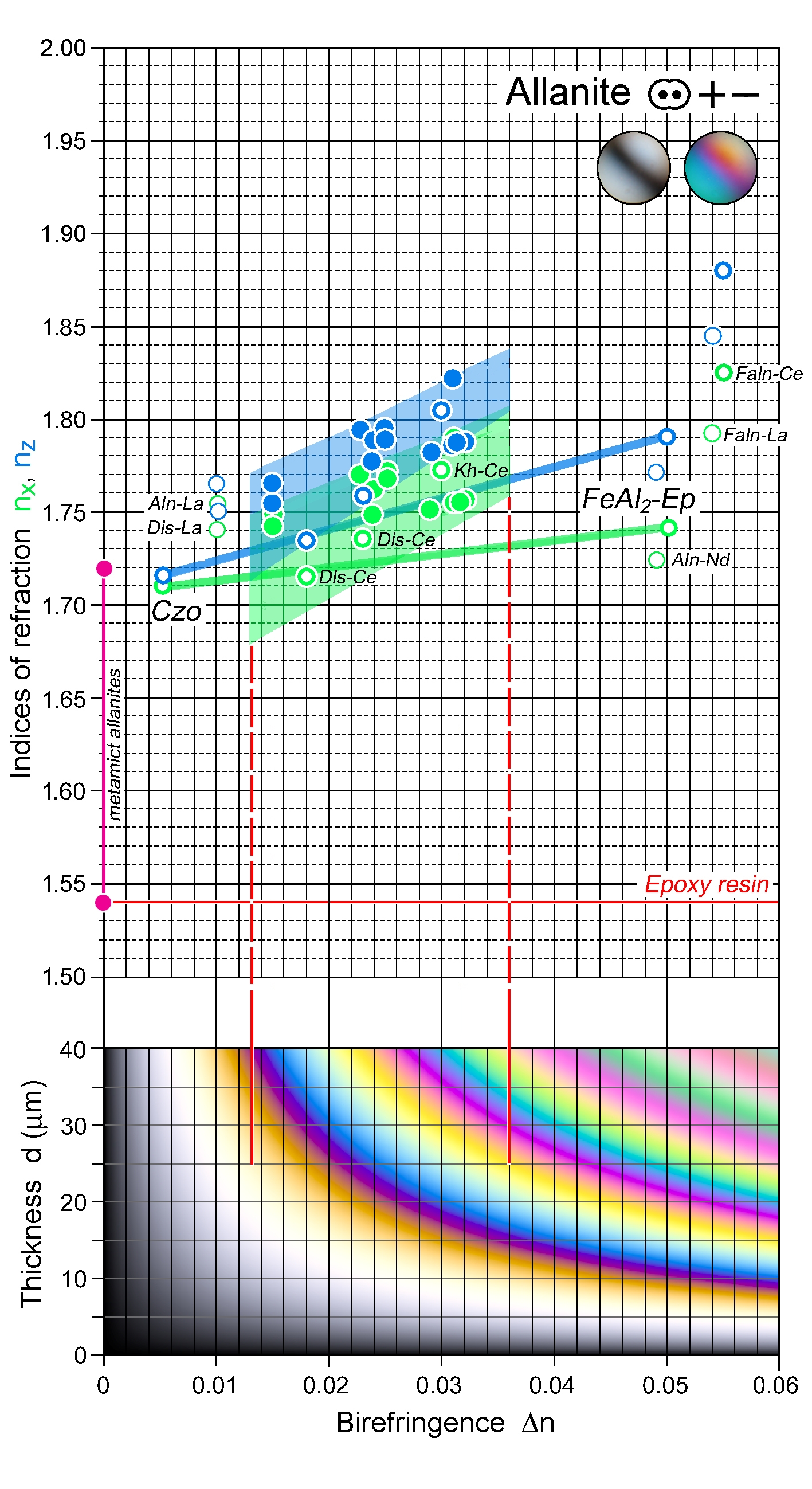|
| Formula | (Ca,Ce,La)2(Al,Fe3+,Fe2+)3O(Si2O7)(SiO4)OH |
| | Optic class & sign | Biaxial positive or negative |
| | Optical orientation | X∧c and Z∧a vary widely, Y = b |
| | Optical plane | (010); may also be normal to (010) |
| | Relief | High |
| | Refractive indices | nx = 1.690 -1.791
|
|
ny = 1.700 -1.815
|
|
nz = 1.706 -1.828
|
|
| n increases with increasing Fe and REE content |
| | Birefringence (max.) | 0.013 - 0.036 |
| | | Δn increases with increasing Fe and REE content |
| | Optic Angle
| 2Vx
= 40 - 90° |
| | 2Vz
= 90 - 57° |
| | Sign of elongation | Length-slow, l (+), and length-fast, l (-), for crystals elongate in b |
| | Interference figure | Strong colour can mask interference colours. Strong optic axis dispersion. Hence, interference figures may not be useful for mineral identification. |
| | Colour / pleochroism | Various shades of brown; green is less common. Distinct pleochroism, usually Z ≥ Y > X. |
| | Zoning | Colour zoning is widespread. Δn zoning may occur. Overgrowths of epidote on allanite are common. |
|
|
| Form | Habit | Granular, columnar, bladed, acicular. Crystals are elongate parallel to b. |
| | | Surface | Euhedral to anhedral |
| | Cleavage | Cleavages are generally not well developed. Most pronounced is the (001) set. |
| | Twinning | (100) rare |
| | Extinction | Straight to (h0k) faces and to (001) cleavage traces in elongate sections (long axis = b). X-Z sections of max Δn show inclined extinction to all morphological elements. |
|
|
| Reaction textures | |
| | Alteration / decomposition | More susceptible to weathering than other members of the epidote group. |
|
|
| Occurence | Ign | Felsic to intermediate igneous rocks |
| | | Met | Schists, gneisses, amphibolite, metamorphosed carbonate-silicate rocks |
| | | Sed | |
| | | Hyd | |
| | | Other | |
|
|
| Distinctive properties | High relief, colour and pleochroism. Pleochroic halos around allanite as inclusions in, or bordering, minerals like biotite, chlorite, amphiboles. |
| | Additional comments | The optical properties of allanite vary over a large n-Δn range reflecting the multitude of possible substitutions, not only REE for Ca, but also on the octahedral M(1) and M(3) positions. The ranges of n listed above apply to the more common allanites. The n-Δn chart shows the main fields for the common allanite compositions, plus nX-nZ pairs for selected REE-rich members of the epidote group. Trends of n and Δn for the clinozoisite-epidote solid solution series are included for reference.
Aln-La - allanite-(La): Orlandi & Pasero (2006), Can. Min. 44, 63-68; Aln-Nd - allanite-(Nd): Skoda et al., Am. Min. 97, 983-988;
Dis-Ce – dissakisite-(Ce), Dls-Ce – dollaseite-(Ce), Faln-Ce – ferriallanite-(Ce), Kh-Ce – khristovite-(Ce): Giere & Sorensen (2004), Rev. Min. & Geochem. 56, 431-493; Dis-La – dissakisite-(La): Tumiati et al. (2005), Am. Min. 90, 1177-1185; Faln-La – ferriallanite-(La): Kolitsch et al. (2012), Eur. J. Min. 24, 741-747.
Metamict allanite is common. Metamict-isotropic varieties: n = 1.54 – 1.72.
Androsite is the Mn-rich equivalent of allanite, with Mn2+ replacing Ca, and Mn3+ as well as Mn2+ in octahedral positions. The refractive indices (mean n = 1.877) are similar to those of ferriallanite. Androsite has a very pronounced pleochroism from X = pale orange-brown to Z = deep brown-red.
|
|
|

 Images
Images  Xl& sections 12-04-24.jpg)


 Images
Images  Xl& sections 12-04-24.jpg)
